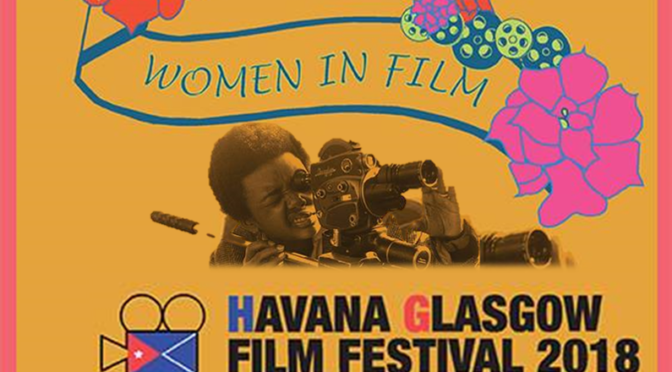This year’s Havana Glasgow Film Festival centred specifically on women working in the film industry. There were several screenings of Patricia Ramos’s EL TECHO, three remastered documentaries from Cuba’s first female filmmaker Sara Gómez and an evening of short films from female cinematographers and directors called, simply, ‘Women in Film’. I came away from ‘Women in Film’ with a revitalised appreciation for film, women, Cuba, the Spanish language, forests and the technical side of film-making in particular.
The night opened with three artistic documentaries vaguely tied together through the theme of change. ORACION/PRAYER FOR MARILYN MONROE (1983) by Marisol Trujillo uses archive material to merge the tales of Marilyn Monroe and Cuba during the 20th century. The script was a reading of Ernesto Cardena’s poem by the same name, which depicts Monroe’s personal struggle in the face of Hollywood stardom. Although the documentary was described as showcasing the life of the troubled star, it’s clear that Trujillo uses Monroe as a symbol for the struggles within Cuba itself; which at first seems an abstract metaphor but works well.
“…Trujillo uses Monroe as a symbol for the struggles within Cuba itself; which at first seems an abstract metaphor but works well.”
Sheyla Pool’s GREAT MUY BIEN (2016) has a distinctly different tone but also looks at Cuba’s social history in a time of change. The documentary is about a group of Cuban English language learners in Havana who range in age, ambition and application. The film is endearing and, at times, tongue in cheek – particularly when the local English teacher completes a learning exercise describing his ‘typical day’ whilst simultaneously performing the actions in a cheesy montage. The audience laughed out loud throughout the documentary, recognising in the characters that bashful awkwardness of learning a new language which is universal. GREAT MUY BIEN shows a changing, outward-looking Havana, where even older generations see the benefits of learning English.
The last documentary of the three also recognised a changing Cuba, this time in terms of flora rather than fauna. EL MONTE (2017) by Claudia Claremi is an award winning short about an old woodsman teaching his granddaughter the ways of the forest. Wise and peaceful, José Manuel talks about the properties of the different plants, comparing good people to beneficial plants and bad people to poisonous ones. He is highly environmentally aware, teaching his granddaughter Melana to scatter seeds so that new fruits will grow. Melana is seen flitting around trees and over streams like some tropical bird, with bare feet and her hair tied in four springy plats; she is a beautiful contrast to her grandfather. EL MONTE uses the juxtaposition of young and old to highlight the changing world of Cuba today; José Manuel worries how the forest will survive if his deep-rooted conservation knowledge is not passed onto the next generation.
“EL MONTE uses the juxtaposition of young and old to highlight the changing world of Cuba today…”
Patricia Ramos’s drama I LOVE LOTUS (2018) broke up the documentary format yet, with its recurring motif of telephones and technology, it still included similar ideas of change. Considering the quality of Ramos’s feature EL TECHO, the short is slightly less impressive than the preceding ones in the program. If there was a message or a bigger point to the film, I missed it. I LOVE LOTUS follows a taciturn security nightguard stationed outside a rundown condom warehouse. He watches the locals, an old woman and an attractive girl, as they use the public telephone outside the warehouse. He manages to ‘seduce’ the girl (or maybe she him), but after a semi-graphic sex scene underneath a pulsating spotlight, she rejects his subsequent advances with a brutally dismissive line, and he rips the phone off the wall.
The good thing about I LOVE LOTUS is that you know where it is going so the story is engaging and there is an element of suspense. There are funny moments and artistic moments and overall the film is appealing.
The program concluded with Deyni D’Atri’s documentary EYES HALF SHUT, a collection of interviews with Cuban female cinematographers. They talked of the prejudices and barriers they faced in the industry, topics which were later broken down and extrapolated in the following Q&A with Patricia Ramos.
Shockingly, I learnt that only 3% of the cinematographers working on major motion pictures today are women. Considering the films just shown, this figure is clearly not due to want of talent, hearing the panel discussion also demonstrated that there is no lack of drive or aspiration. One can only speculate that female cinematographers are so few and far between because the industry doesn’t allow for them, or perhaps women feel intimidated by the male-dominated industry and so lack confidence in their technical abilities.
Scotland and Cuba have, according to the panel, similar film industries; both relatively small, with a surmountable grassroots network, geographically removed from the crucibles of the industry (London, Hollywood) and often lacking in funding and opportunities.
The overwhelming feeling of ‘Women in Film’ defied all this however, change, it says, is possible and will happen. It is for women (and other minorities in film) to lead the way and begin this change.

